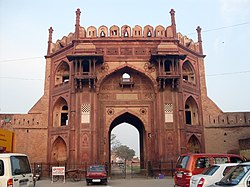Nurmahal
| Nurmahal | ||
|---|---|---|
|
|
||
| State : |
|
|
| State : | Punjab | |
| District : | Jalandhar | |
| Location : | 31 ° 6 ′ N , 75 ° 36 ′ E | |
| Height : | 238 m | |
| Area : | 6.15 km² | |
| Residents : | 14,560 (2011) | |
| Population density : | 2367 inhabitants / km² | |
| Nurmahal - gate construction of the caravanserai | ||
Nurmahal ( Panjabi : ਨੂਰਮਹਿਲ, Urdu : نورمحل) is a small town with around 15,000 inhabitants in the Indian state of Punjab .
location
The place Nurmahal is approx. 30 km (driving distance) south of the district capital Jalandhar at an altitude of approx. 240 m above sea level. d. M. The climate is temperate to warm; Rain actually only falls during the summer monsoon season .
population
Official population statistics have only been kept since 1991 and are published regularly. The sustained increase in urban population is mainly due to the immigration of families from the surrounding area.
| year | 1991 | 2001 | 2011 |
| Residents | 11,149 | 12,632 | 14,560 |
Almost 83% of the population are Hindus , almost 15% are Sikhs and only a good 1.5% are Muslims ; other religions such as Christians form splinter groups. The proportion of the male population is about 7% higher than the female population. They speak Punjabi , Hindi and Urdu .
economy
The area around Nurmahal is largely agricultural; Traders, craftsmen and day laborers have settled in the small town.
history
The place was apparently already in the Middle Ages a resting place for caravans on their way through the Ganges plain to the northwest; this route was expanded around the middle of the 16th century by the occupier Sher Khan Suri and then by the Mughals - later it was named Grand Trunk Road . It is believed that the Mughal princess un multiple-Nisa that of her future husband, the Mughal emperor Jahangir , Nur Jahan was called, here some spent their childhood and youth, because in 1618 she gave the order to build a walled caravansary , from which the entire place got its current name.
Attractions
The only attraction of the place is the caravanserai measuring approx. 168 m in a square with its gate , which was designed in the style of the Mughal architecture that was prevalent at the time . The core of the structure consists of fired bricks , which were clad with slabs of red and yellowish sandstone from Rajasthan . A raised central divan forms the framework for the actual portal, which is framed by a band of letters and animal reliefs (elephants, etc.); in the middle above the portal opening there is a small balcony ( jharokha ). The side surfaces are also richly decorated for a functional building; The two large balconies in the upper area are particularly striking, but their original guard function has given way exclusively to representative purposes. The three-storey side parts of the building are sloping towards the rear.
On a several meter high substructure in the actual courtyard area there is a small plastered mosque with a central dome and two large stone jali windows as well as a draw well; A total of 32 open storage rooms are connected to the western outer wall, in which the caravan drivers could also find nightly quiet.
Web links
- Nurmahal, Caravanserai - Photo + Info (English)
- Nurmahal, Caravanserai - Photo + Info (English)
- Nurmahal, caravanserai - photo + information (Wikipedia, English)
- Historic buildings in the district of Jalandhar - Photos and information (English)


